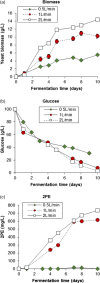Elevated production of the aromatic fragrance molecule, 2-phenylethanol, using Metschnikowia pulcherrima through both de novo and ex novo conversion in batch and continuous modes
- PMID: 30069076
- PMCID: PMC6055805
- DOI: 10.1002/jctb.5597
Elevated production of the aromatic fragrance molecule, 2-phenylethanol, using Metschnikowia pulcherrima through both de novo and ex novo conversion in batch and continuous modes
Abstract
Background: 2-phenylethanol (2PE) is a fragrance molecule predominantly used in perfumes and the food industry. It can be made from petrochemicals inexpensively, however, this is unsuitable for most food applications. Currently, the main method of production for the bio-derived compound is to extract the trace amounts found in rose petals, which is extremely costly. Potentially fermentation could provide an inexpensive, naturally sourced, alternative.
Results: In this investigation, 2PE was produced from the yeast Metschnikowia pulcherrima, optimised in flasks before scaling to 2 L batch and continuous operation. 2PE can be produced in high titres under de novo process conditions with up to 1500 mg L-1 achieved in a 2 L stirred bioreactor. This is the highest reported de novo titre to date, and achieved through high sugar loadings coupled with low nitrogen conditions. The process successfully ran in continuous mode also, with a concentration of 650 mg L-1 of 2PE being maintained. The 2PE production was further increased by the ex novo conversion of phenylalanine and semi-continuous solid phase extraction from the supernatant. Under optimal conditions 14 000 mg L-1 of 2PE was produced.
Conclusions: The work presented here offers a novel route to naturally sourced 2PE through a scalable fermentation with a robust yeast highly suited to industrial biotechnology. © 2018 The Authors. Journal of Chemical Technology & Biotechnology published by John Wiley & Sons Ltd on behalf of Society of Chemical Industry.
Keywords: Adsorption; Biochemical engineering; Bioprocesses; Engineering; Green Engineering/Products; Industrial biotechnology.
Figures










References
-
- Hua DL and Xu P, Recent advances in biotechnological production of 2‐phenylethanol. Biotechnol Adv 29:654–660 (2011). - PubMed
-
- Bauer K, Garbe D and Surburg H, Common Fragrance and Flavor Materials: Preparation, Properties and Uses. Wiley‐VCH Verlang GmbH, Holzminden: (2008).
-
- Salhe A and Potting D, Environmental life cycle assessment of Ethiopian rose cultivation. Sci Total Environ 443:163–172 (2013). - PubMed
-
- Zander K and Hamm U, Consumer preferences for additional ethical attributes of organic food. Food Quality Prefer 21:495–503 (2010).
-
- Herrmann KM and Weaver LM, The shikimate pathway. Annu Rev Plant Physiol Plant Mol Biol 50:473–503 (1999). - PubMed
LinkOut - more resources
Full Text Sources
Other Literature Sources
Miscellaneous
